Economic Principles and Decision Making Report - Semester Analysis
VerifiedAdded on 2020/02/24
|16
|2797
|55
Report
AI Summary
This report provides an in-depth analysis of economic principles and their application in decision-making, focusing on the factors influencing demand. The report begins with an introduction to key economic variables and their impact on market dynamics. It then delves into theoretical evaluations using concepts like supply and demand, aggregate supply and demand, the Phillips curve, and the Laffer curve. Furthermore, the report conducts an empirical evaluation using multiple regression analysis to assess the relationship between demand for a new energy bar and variables like income, inflation, and tariff rates. The analysis includes regression results and coefficient interpretations, followed by recommendations for the company, Schmeckt Gut, based on different market scenarios. The report aims to assist the company in launching its product by providing insights into market conditions and demand projections.
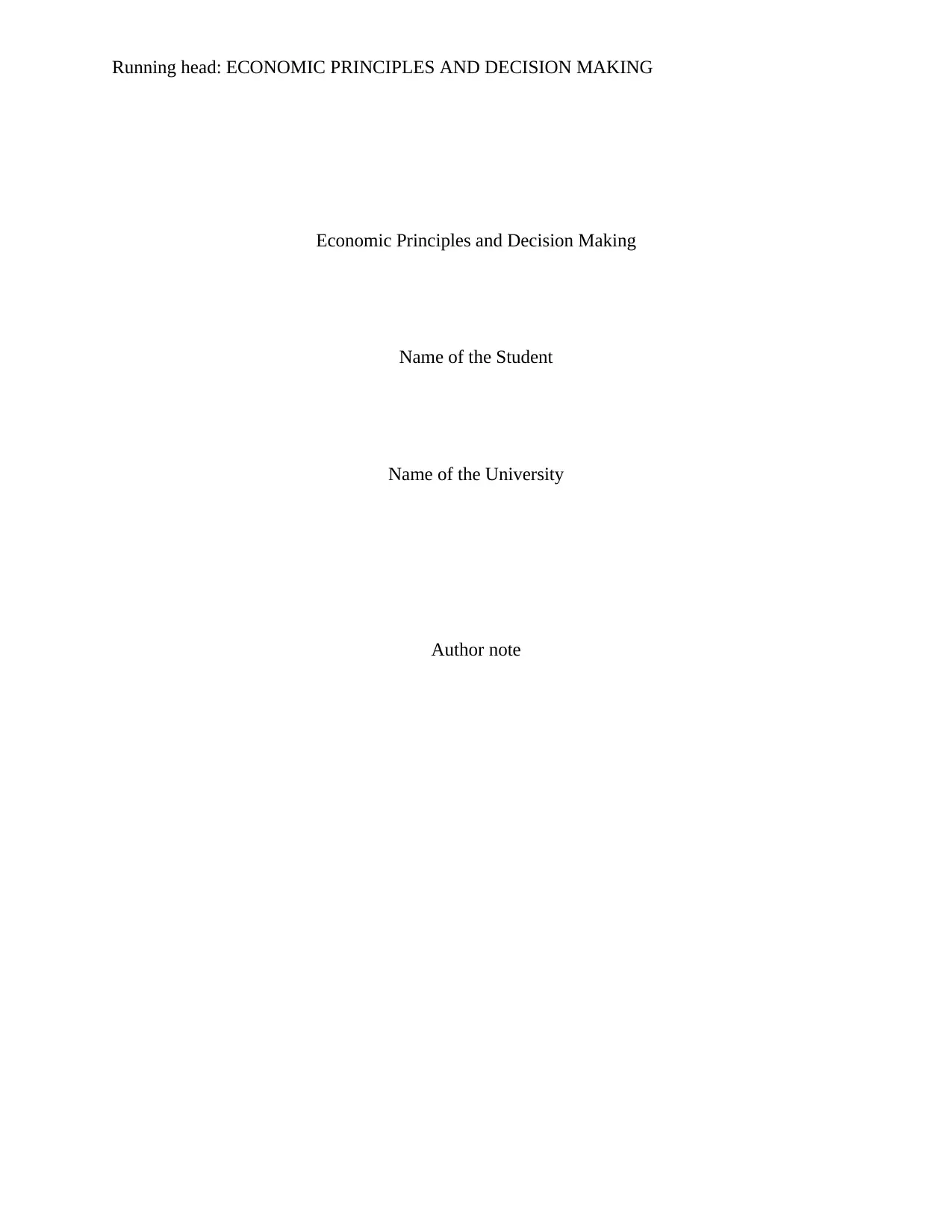
Running head: ECONOMIC PRINCIPLES AND DECISION MAKING
Economic Principles and Decision Making
Name of the Student
Name of the University
Author note
Economic Principles and Decision Making
Name of the Student
Name of the University
Author note
Paraphrase This Document
Need a fresh take? Get an instant paraphrase of this document with our AI Paraphraser
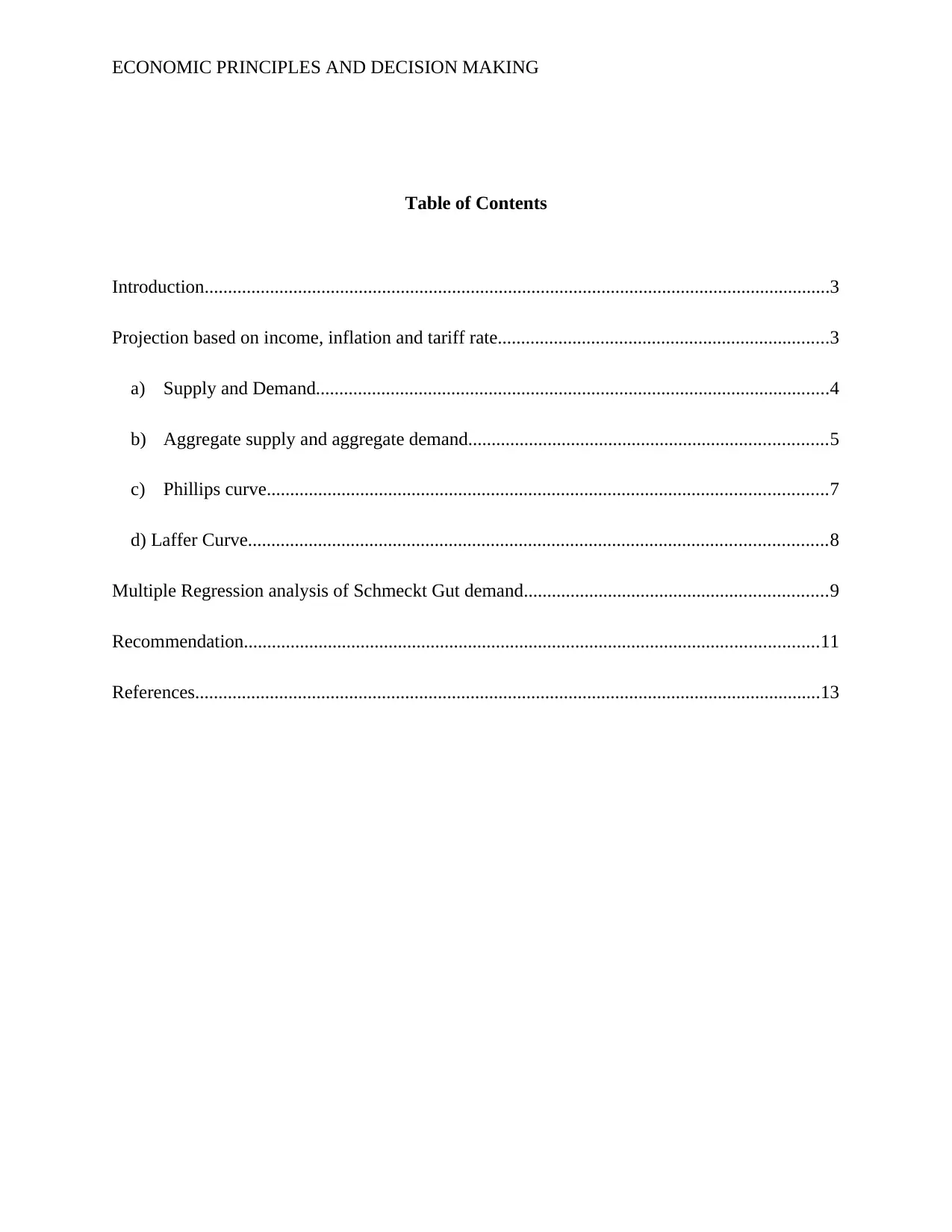
ECONOMIC PRINCIPLES AND DECISION MAKING
Table of Contents
Introduction......................................................................................................................................3
Projection based on income, inflation and tariff rate.......................................................................3
a) Supply and Demand..............................................................................................................4
b) Aggregate supply and aggregate demand.............................................................................5
c) Phillips curve........................................................................................................................7
d) Laffer Curve............................................................................................................................8
Multiple Regression analysis of Schmeckt Gut demand.................................................................9
Recommendation...........................................................................................................................11
References......................................................................................................................................13
Table of Contents
Introduction......................................................................................................................................3
Projection based on income, inflation and tariff rate.......................................................................3
a) Supply and Demand..............................................................................................................4
b) Aggregate supply and aggregate demand.............................................................................5
c) Phillips curve........................................................................................................................7
d) Laffer Curve............................................................................................................................8
Multiple Regression analysis of Schmeckt Gut demand.................................................................9
Recommendation...........................................................................................................................11
References......................................................................................................................................13
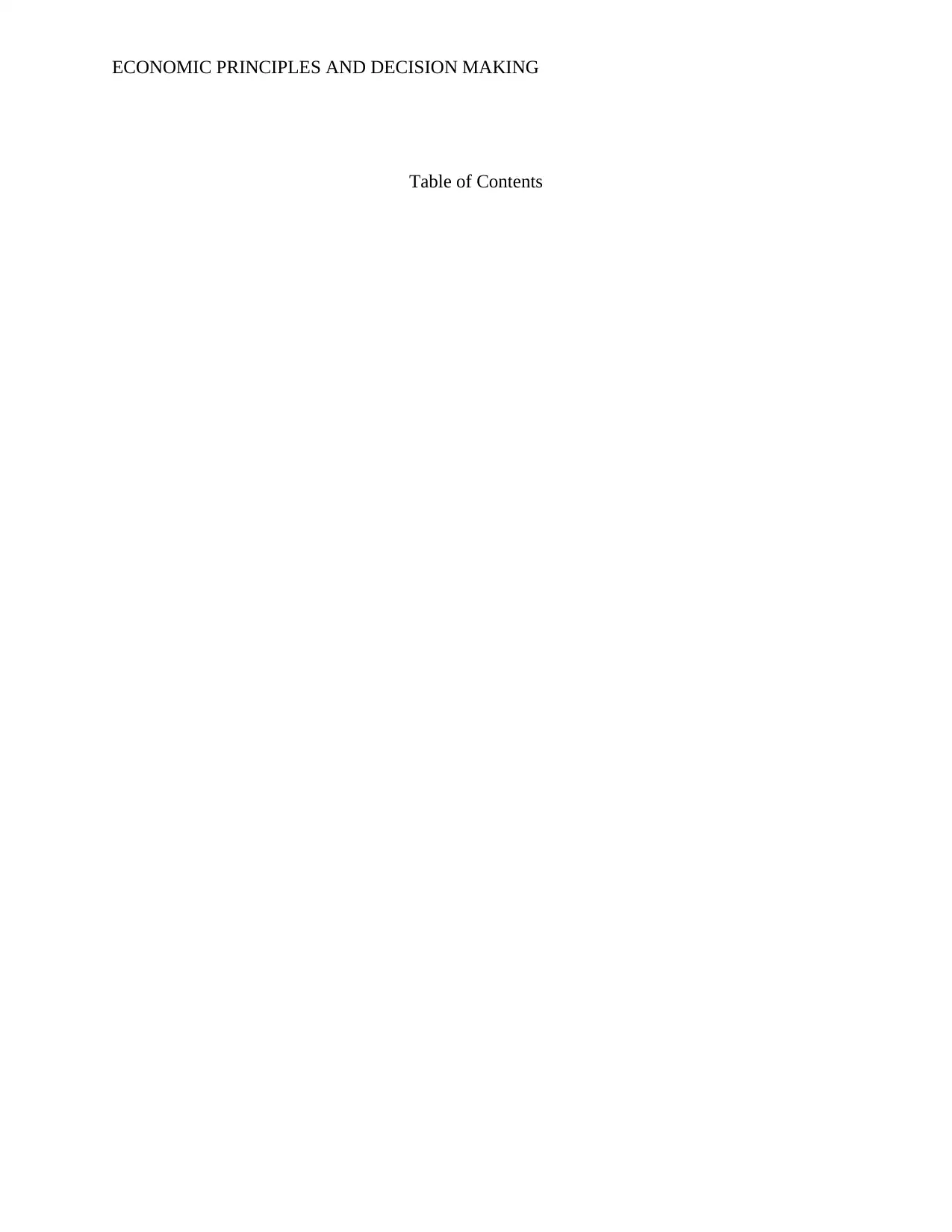
ECONOMIC PRINCIPLES AND DECISION MAKING
Table of Contents
Table of Contents
⊘ This is a preview!⊘
Do you want full access?
Subscribe today to unlock all pages.

Trusted by 1+ million students worldwide
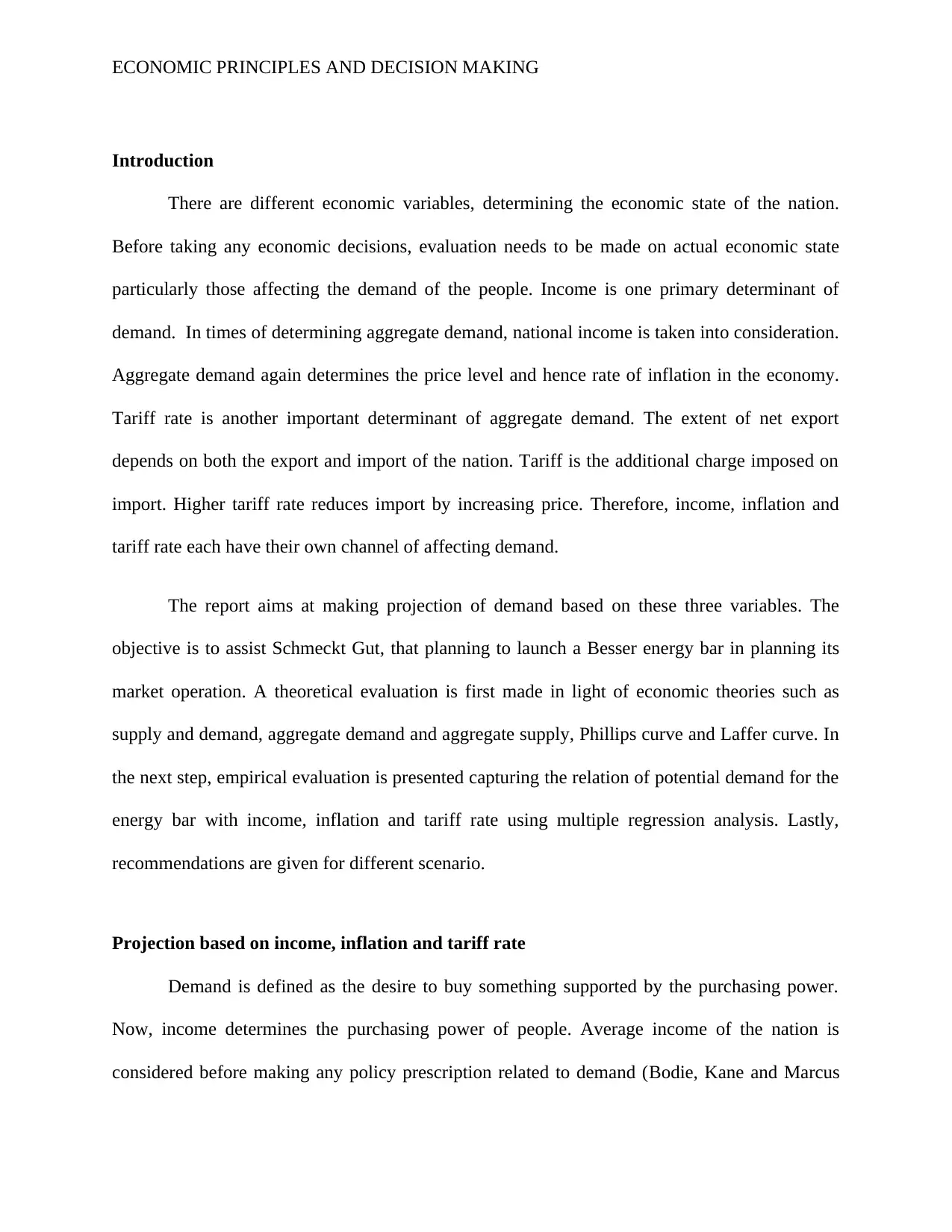
ECONOMIC PRINCIPLES AND DECISION MAKING
Introduction
There are different economic variables, determining the economic state of the nation.
Before taking any economic decisions, evaluation needs to be made on actual economic state
particularly those affecting the demand of the people. Income is one primary determinant of
demand. In times of determining aggregate demand, national income is taken into consideration.
Aggregate demand again determines the price level and hence rate of inflation in the economy.
Tariff rate is another important determinant of aggregate demand. The extent of net export
depends on both the export and import of the nation. Tariff is the additional charge imposed on
import. Higher tariff rate reduces import by increasing price. Therefore, income, inflation and
tariff rate each have their own channel of affecting demand.
The report aims at making projection of demand based on these three variables. The
objective is to assist Schmeckt Gut, that planning to launch a Besser energy bar in planning its
market operation. A theoretical evaluation is first made in light of economic theories such as
supply and demand, aggregate demand and aggregate supply, Phillips curve and Laffer curve. In
the next step, empirical evaluation is presented capturing the relation of potential demand for the
energy bar with income, inflation and tariff rate using multiple regression analysis. Lastly,
recommendations are given for different scenario.
Projection based on income, inflation and tariff rate
Demand is defined as the desire to buy something supported by the purchasing power.
Now, income determines the purchasing power of people. Average income of the nation is
considered before making any policy prescription related to demand (Bodie, Kane and Marcus
Introduction
There are different economic variables, determining the economic state of the nation.
Before taking any economic decisions, evaluation needs to be made on actual economic state
particularly those affecting the demand of the people. Income is one primary determinant of
demand. In times of determining aggregate demand, national income is taken into consideration.
Aggregate demand again determines the price level and hence rate of inflation in the economy.
Tariff rate is another important determinant of aggregate demand. The extent of net export
depends on both the export and import of the nation. Tariff is the additional charge imposed on
import. Higher tariff rate reduces import by increasing price. Therefore, income, inflation and
tariff rate each have their own channel of affecting demand.
The report aims at making projection of demand based on these three variables. The
objective is to assist Schmeckt Gut, that planning to launch a Besser energy bar in planning its
market operation. A theoretical evaluation is first made in light of economic theories such as
supply and demand, aggregate demand and aggregate supply, Phillips curve and Laffer curve. In
the next step, empirical evaluation is presented capturing the relation of potential demand for the
energy bar with income, inflation and tariff rate using multiple regression analysis. Lastly,
recommendations are given for different scenario.
Projection based on income, inflation and tariff rate
Demand is defined as the desire to buy something supported by the purchasing power.
Now, income determines the purchasing power of people. Average income of the nation is
considered before making any policy prescription related to demand (Bodie, Kane and Marcus
Paraphrase This Document
Need a fresh take? Get an instant paraphrase of this document with our AI Paraphraser

ECONOMIC PRINCIPLES AND DECISION MAKING
2014). Income is related with variables such as consumption, general price level, structure of tax
and pattern of export import. An increase in income has a direct income on the consumption
basket of the household. Part of the increased income is also saved affecting the investment level
of country. Rise in demand lead to a rise in overall price level termed as inflation. The demand
for imported goods depends on import price. A tariff generally raises the domestic price for
import (Svensson 2016). Hence, demand projection is made using basic micro and
macroeconomic theories. The theories are briefly discussed below:
a) Supply and Demand
Demand of a good or service is the people’s desire for the good or service supported by
the purchasing power that is determined by their disposable income. Supply on the other hand is
the quantity that suppliers willing to sell at market determined price (Azevedo and Leshno 2016).
When income increases then demand for both the domestic goods and imported goods increased.
People prefer to have a quality life. To have a healthy life, more people willing to join a gym and
this may result in opening of new gyms in Atollia. With joining gym, people demand other
healthy product to support their physical workout. Energy bars are made to provide energy
equivalent to a complete meal. These are generally costly than average meal. People with a rise
in income and improved quality of life may increase their demand for energy bars. Therefore, the
plan of launching new energy bar may have great success with a pre prepared market demand for
energy bar. The data collected for demand analysis show an increase in income over the years.
Income increase is responsible for causing demand-push inflation in the economy.
Average inflation rate in the last five years can be approximated as 2%. A moderate inflation rate
encourages suppliers to increase their supply given possibility of increased profitability. High
price attracts domestic as well as foreign suppliers to do business in the market. Sometimes
2014). Income is related with variables such as consumption, general price level, structure of tax
and pattern of export import. An increase in income has a direct income on the consumption
basket of the household. Part of the increased income is also saved affecting the investment level
of country. Rise in demand lead to a rise in overall price level termed as inflation. The demand
for imported goods depends on import price. A tariff generally raises the domestic price for
import (Svensson 2016). Hence, demand projection is made using basic micro and
macroeconomic theories. The theories are briefly discussed below:
a) Supply and Demand
Demand of a good or service is the people’s desire for the good or service supported by
the purchasing power that is determined by their disposable income. Supply on the other hand is
the quantity that suppliers willing to sell at market determined price (Azevedo and Leshno 2016).
When income increases then demand for both the domestic goods and imported goods increased.
People prefer to have a quality life. To have a healthy life, more people willing to join a gym and
this may result in opening of new gyms in Atollia. With joining gym, people demand other
healthy product to support their physical workout. Energy bars are made to provide energy
equivalent to a complete meal. These are generally costly than average meal. People with a rise
in income and improved quality of life may increase their demand for energy bars. Therefore, the
plan of launching new energy bar may have great success with a pre prepared market demand for
energy bar. The data collected for demand analysis show an increase in income over the years.
Income increase is responsible for causing demand-push inflation in the economy.
Average inflation rate in the last five years can be approximated as 2%. A moderate inflation rate
encourages suppliers to increase their supply given possibility of increased profitability. High
price attracts domestic as well as foreign suppliers to do business in the market. Sometimes
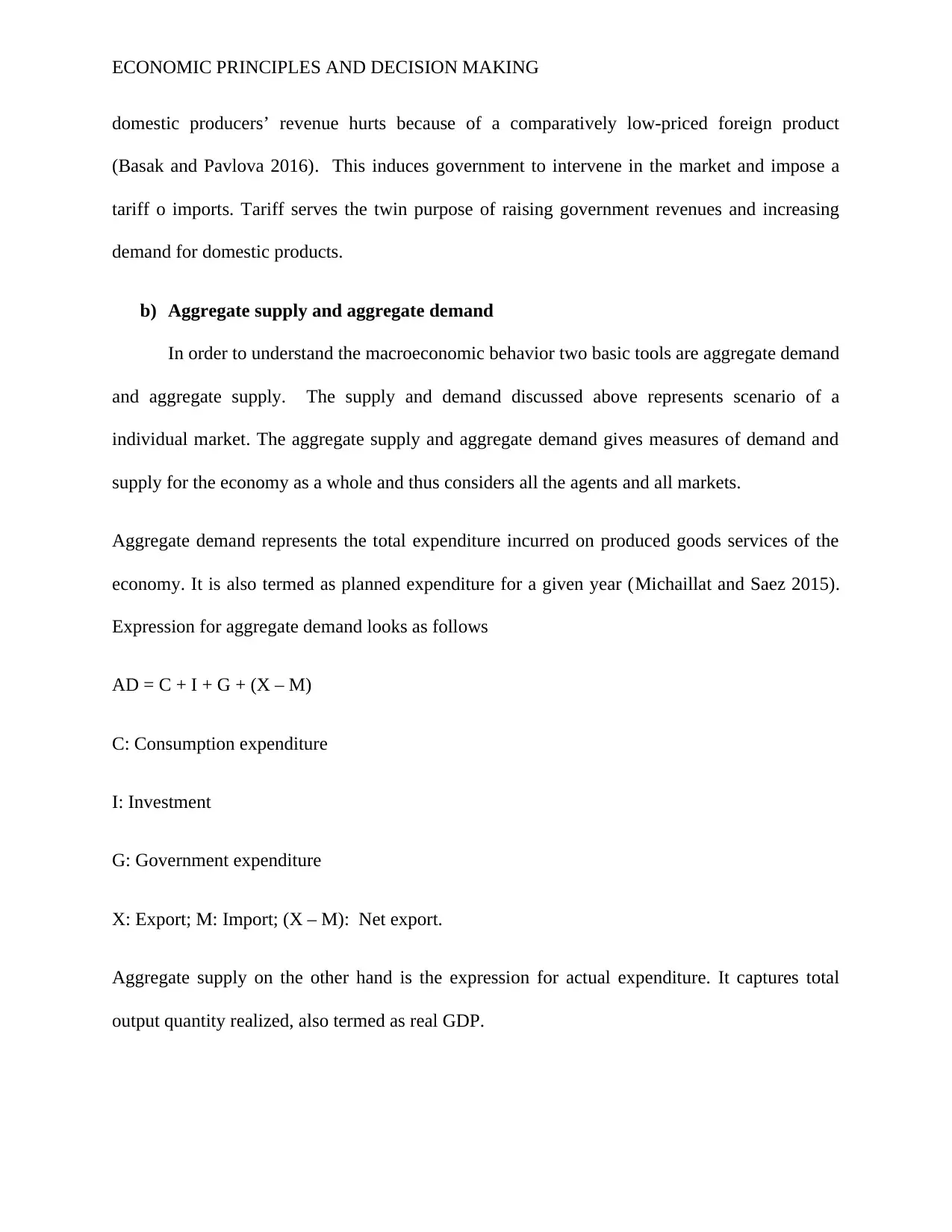
ECONOMIC PRINCIPLES AND DECISION MAKING
domestic producers’ revenue hurts because of a comparatively low-priced foreign product
(Basak and Pavlova 2016). This induces government to intervene in the market and impose a
tariff o imports. Tariff serves the twin purpose of raising government revenues and increasing
demand for domestic products.
b) Aggregate supply and aggregate demand
In order to understand the macroeconomic behavior two basic tools are aggregate demand
and aggregate supply. The supply and demand discussed above represents scenario of a
individual market. The aggregate supply and aggregate demand gives measures of demand and
supply for the economy as a whole and thus considers all the agents and all markets.
Aggregate demand represents the total expenditure incurred on produced goods services of the
economy. It is also termed as planned expenditure for a given year (Michaillat and Saez 2015).
Expression for aggregate demand looks as follows
AD = C + I + G + (X – M)
C: Consumption expenditure
I: Investment
G: Government expenditure
X: Export; M: Import; (X – M): Net export.
Aggregate supply on the other hand is the expression for actual expenditure. It captures total
output quantity realized, also termed as real GDP.
domestic producers’ revenue hurts because of a comparatively low-priced foreign product
(Basak and Pavlova 2016). This induces government to intervene in the market and impose a
tariff o imports. Tariff serves the twin purpose of raising government revenues and increasing
demand for domestic products.
b) Aggregate supply and aggregate demand
In order to understand the macroeconomic behavior two basic tools are aggregate demand
and aggregate supply. The supply and demand discussed above represents scenario of a
individual market. The aggregate supply and aggregate demand gives measures of demand and
supply for the economy as a whole and thus considers all the agents and all markets.
Aggregate demand represents the total expenditure incurred on produced goods services of the
economy. It is also termed as planned expenditure for a given year (Michaillat and Saez 2015).
Expression for aggregate demand looks as follows
AD = C + I + G + (X – M)
C: Consumption expenditure
I: Investment
G: Government expenditure
X: Export; M: Import; (X – M): Net export.
Aggregate supply on the other hand is the expression for actual expenditure. It captures total
output quantity realized, also termed as real GDP.
⊘ This is a preview!⊘
Do you want full access?
Subscribe today to unlock all pages.

Trusted by 1+ million students worldwide
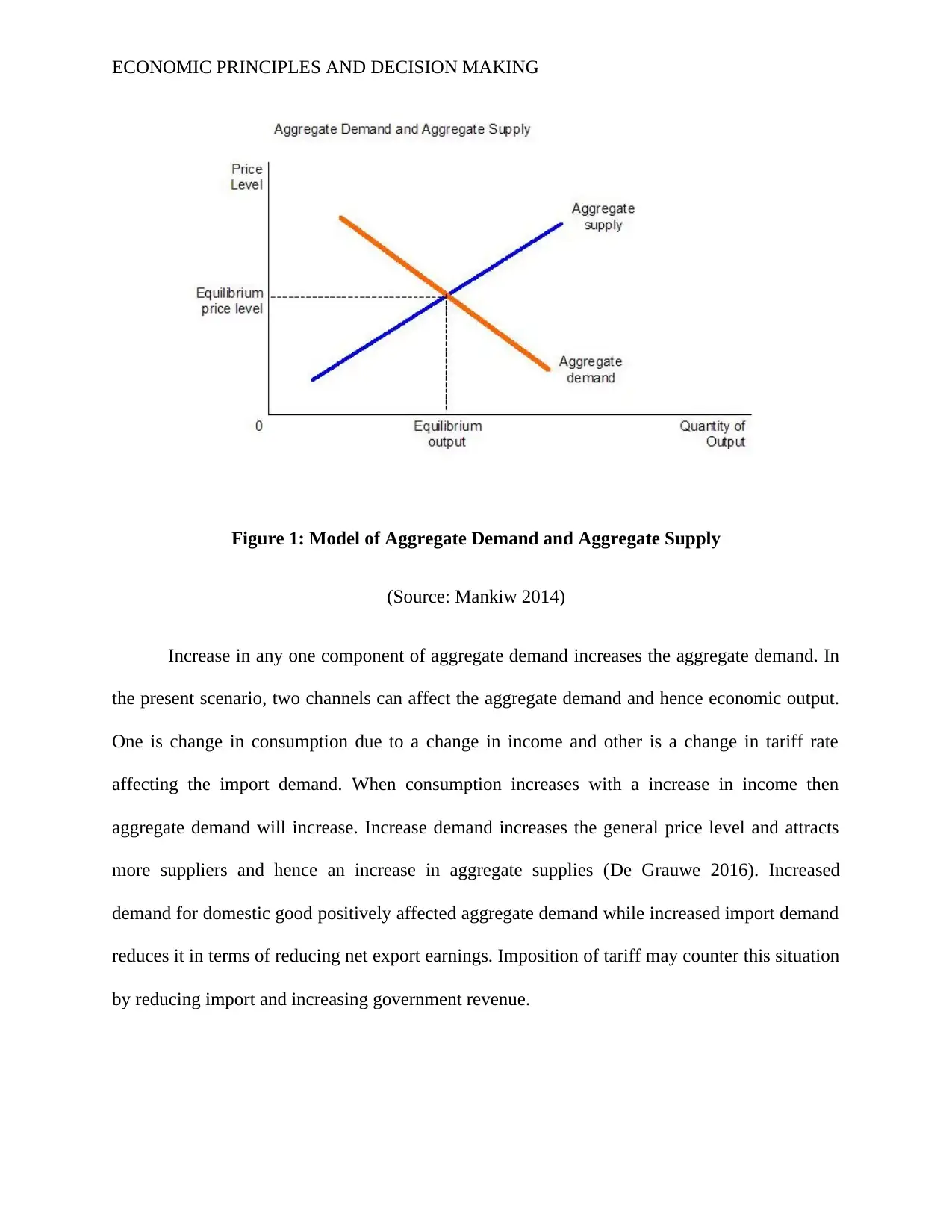
ECONOMIC PRINCIPLES AND DECISION MAKING
Figure 1: Model of Aggregate Demand and Aggregate Supply
(Source: Mankiw 2014)
Increase in any one component of aggregate demand increases the aggregate demand. In
the present scenario, two channels can affect the aggregate demand and hence economic output.
One is change in consumption due to a change in income and other is a change in tariff rate
affecting the import demand. When consumption increases with a increase in income then
aggregate demand will increase. Increase demand increases the general price level and attracts
more suppliers and hence an increase in aggregate supplies (De Grauwe 2016). Increased
demand for domestic good positively affected aggregate demand while increased import demand
reduces it in terms of reducing net export earnings. Imposition of tariff may counter this situation
by reducing import and increasing government revenue.
Figure 1: Model of Aggregate Demand and Aggregate Supply
(Source: Mankiw 2014)
Increase in any one component of aggregate demand increases the aggregate demand. In
the present scenario, two channels can affect the aggregate demand and hence economic output.
One is change in consumption due to a change in income and other is a change in tariff rate
affecting the import demand. When consumption increases with a increase in income then
aggregate demand will increase. Increase demand increases the general price level and attracts
more suppliers and hence an increase in aggregate supplies (De Grauwe 2016). Increased
demand for domestic good positively affected aggregate demand while increased import demand
reduces it in terms of reducing net export earnings. Imposition of tariff may counter this situation
by reducing import and increasing government revenue.
Paraphrase This Document
Need a fresh take? Get an instant paraphrase of this document with our AI Paraphraser
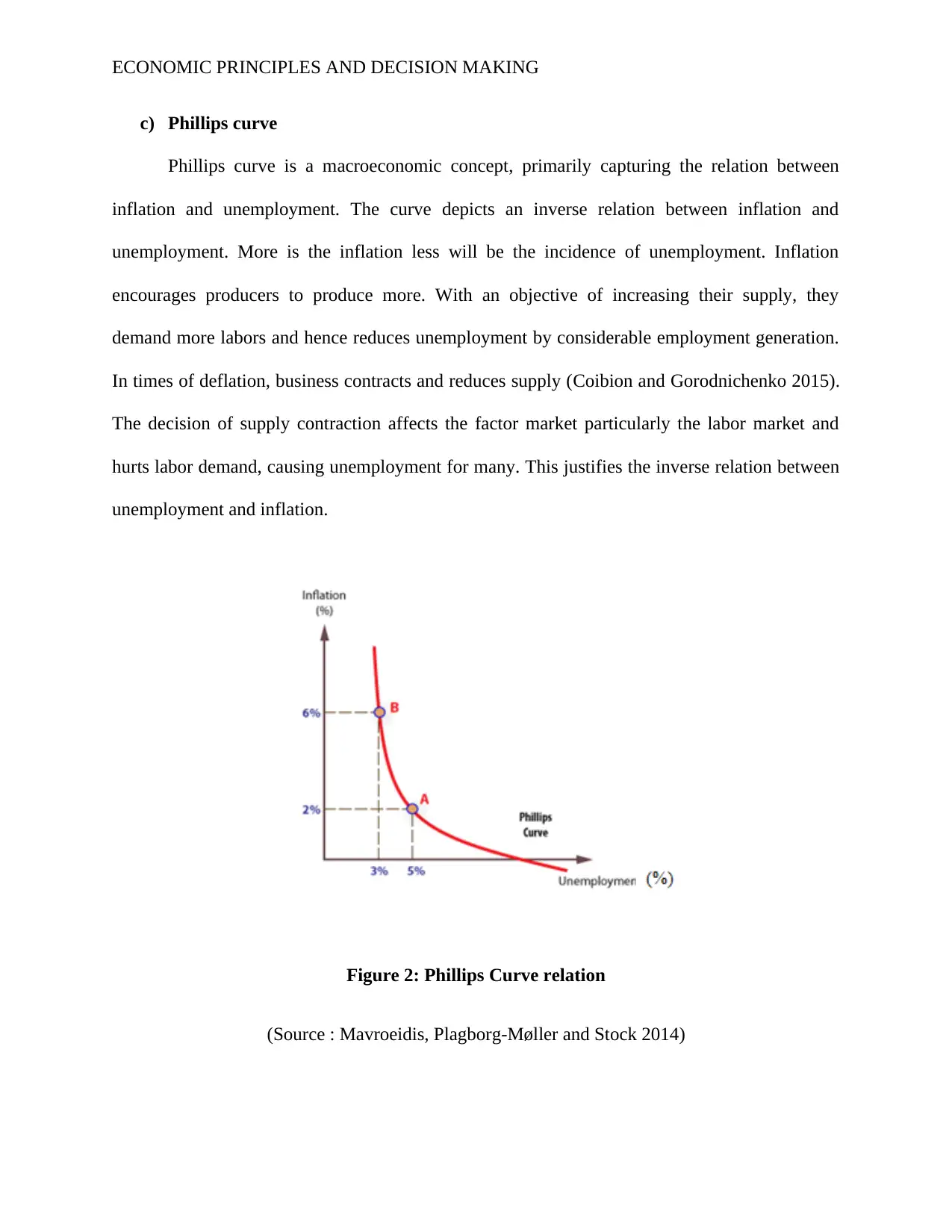
ECONOMIC PRINCIPLES AND DECISION MAKING
c) Phillips curve
Phillips curve is a macroeconomic concept, primarily capturing the relation between
inflation and unemployment. The curve depicts an inverse relation between inflation and
unemployment. More is the inflation less will be the incidence of unemployment. Inflation
encourages producers to produce more. With an objective of increasing their supply, they
demand more labors and hence reduces unemployment by considerable employment generation.
In times of deflation, business contracts and reduces supply (Coibion and Gorodnichenko 2015).
The decision of supply contraction affects the factor market particularly the labor market and
hurts labor demand, causing unemployment for many. This justifies the inverse relation between
unemployment and inflation.
Figure 2: Phillips Curve relation
(Source : Mavroeidis, Plagborg-Møller and Stock 2014)
c) Phillips curve
Phillips curve is a macroeconomic concept, primarily capturing the relation between
inflation and unemployment. The curve depicts an inverse relation between inflation and
unemployment. More is the inflation less will be the incidence of unemployment. Inflation
encourages producers to produce more. With an objective of increasing their supply, they
demand more labors and hence reduces unemployment by considerable employment generation.
In times of deflation, business contracts and reduces supply (Coibion and Gorodnichenko 2015).
The decision of supply contraction affects the factor market particularly the labor market and
hurts labor demand, causing unemployment for many. This justifies the inverse relation between
unemployment and inflation.
Figure 2: Phillips Curve relation
(Source : Mavroeidis, Plagborg-Møller and Stock 2014)

ECONOMIC PRINCIPLES AND DECISION MAKING
In connection to present situation, increased demand resulted from increased income may
creates an inflationary pressure. In view of Phillips curve relation, this has the potentiality of
reducing unemployment. Any anti inflationary measure in this situation may hamper
employment scenario in the economy (Madeira 2014). Therefore, measures restricting inflation
rate should be taken up to limited extend. This is for the simple reason, inflation help to maintain
unemployment at a desirable level.
d) Laffer Curve
Laffer curve explains the relation between any type of tax rate and resulted government
revenues from it. Tax on import is known as the tariff rate (Badel and Huggett 2017). By the
virtue of Laffer relation, it shows that too high tariff rate hurts government revenue instead of
increasing it.
Figure 3: Laffer curve
(Source : Busato and Chiarini 2013)
In connection to present situation, increased demand resulted from increased income may
creates an inflationary pressure. In view of Phillips curve relation, this has the potentiality of
reducing unemployment. Any anti inflationary measure in this situation may hamper
employment scenario in the economy (Madeira 2014). Therefore, measures restricting inflation
rate should be taken up to limited extend. This is for the simple reason, inflation help to maintain
unemployment at a desirable level.
d) Laffer Curve
Laffer curve explains the relation between any type of tax rate and resulted government
revenues from it. Tax on import is known as the tariff rate (Badel and Huggett 2017). By the
virtue of Laffer relation, it shows that too high tariff rate hurts government revenue instead of
increasing it.
Figure 3: Laffer curve
(Source : Busato and Chiarini 2013)
⊘ This is a preview!⊘
Do you want full access?
Subscribe today to unlock all pages.

Trusted by 1+ million students worldwide
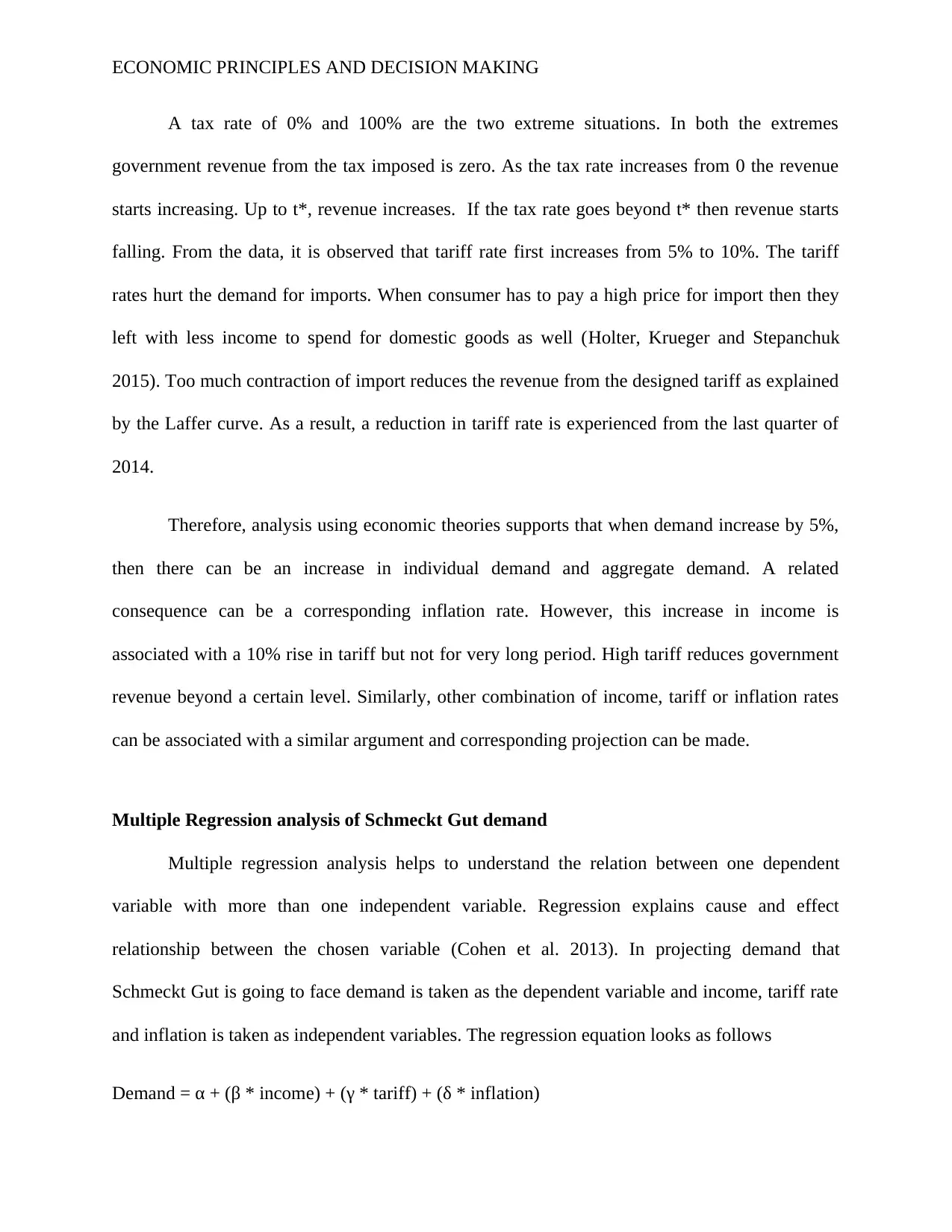
ECONOMIC PRINCIPLES AND DECISION MAKING
A tax rate of 0% and 100% are the two extreme situations. In both the extremes
government revenue from the tax imposed is zero. As the tax rate increases from 0 the revenue
starts increasing. Up to t*, revenue increases. If the tax rate goes beyond t* then revenue starts
falling. From the data, it is observed that tariff rate first increases from 5% to 10%. The tariff
rates hurt the demand for imports. When consumer has to pay a high price for import then they
left with less income to spend for domestic goods as well (Holter, Krueger and Stepanchuk
2015). Too much contraction of import reduces the revenue from the designed tariff as explained
by the Laffer curve. As a result, a reduction in tariff rate is experienced from the last quarter of
2014.
Therefore, analysis using economic theories supports that when demand increase by 5%,
then there can be an increase in individual demand and aggregate demand. A related
consequence can be a corresponding inflation rate. However, this increase in income is
associated with a 10% rise in tariff but not for very long period. High tariff reduces government
revenue beyond a certain level. Similarly, other combination of income, tariff or inflation rates
can be associated with a similar argument and corresponding projection can be made.
Multiple Regression analysis of Schmeckt Gut demand
Multiple regression analysis helps to understand the relation between one dependent
variable with more than one independent variable. Regression explains cause and effect
relationship between the chosen variable (Cohen et al. 2013). In projecting demand that
Schmeckt Gut is going to face demand is taken as the dependent variable and income, tariff rate
and inflation is taken as independent variables. The regression equation looks as follows
Demand = α + (β * income) + (γ * tariff) + (δ * inflation)
A tax rate of 0% and 100% are the two extreme situations. In both the extremes
government revenue from the tax imposed is zero. As the tax rate increases from 0 the revenue
starts increasing. Up to t*, revenue increases. If the tax rate goes beyond t* then revenue starts
falling. From the data, it is observed that tariff rate first increases from 5% to 10%. The tariff
rates hurt the demand for imports. When consumer has to pay a high price for import then they
left with less income to spend for domestic goods as well (Holter, Krueger and Stepanchuk
2015). Too much contraction of import reduces the revenue from the designed tariff as explained
by the Laffer curve. As a result, a reduction in tariff rate is experienced from the last quarter of
2014.
Therefore, analysis using economic theories supports that when demand increase by 5%,
then there can be an increase in individual demand and aggregate demand. A related
consequence can be a corresponding inflation rate. However, this increase in income is
associated with a 10% rise in tariff but not for very long period. High tariff reduces government
revenue beyond a certain level. Similarly, other combination of income, tariff or inflation rates
can be associated with a similar argument and corresponding projection can be made.
Multiple Regression analysis of Schmeckt Gut demand
Multiple regression analysis helps to understand the relation between one dependent
variable with more than one independent variable. Regression explains cause and effect
relationship between the chosen variable (Cohen et al. 2013). In projecting demand that
Schmeckt Gut is going to face demand is taken as the dependent variable and income, tariff rate
and inflation is taken as independent variables. The regression equation looks as follows
Demand = α + (β * income) + (γ * tariff) + (δ * inflation)
Paraphrase This Document
Need a fresh take? Get an instant paraphrase of this document with our AI Paraphraser
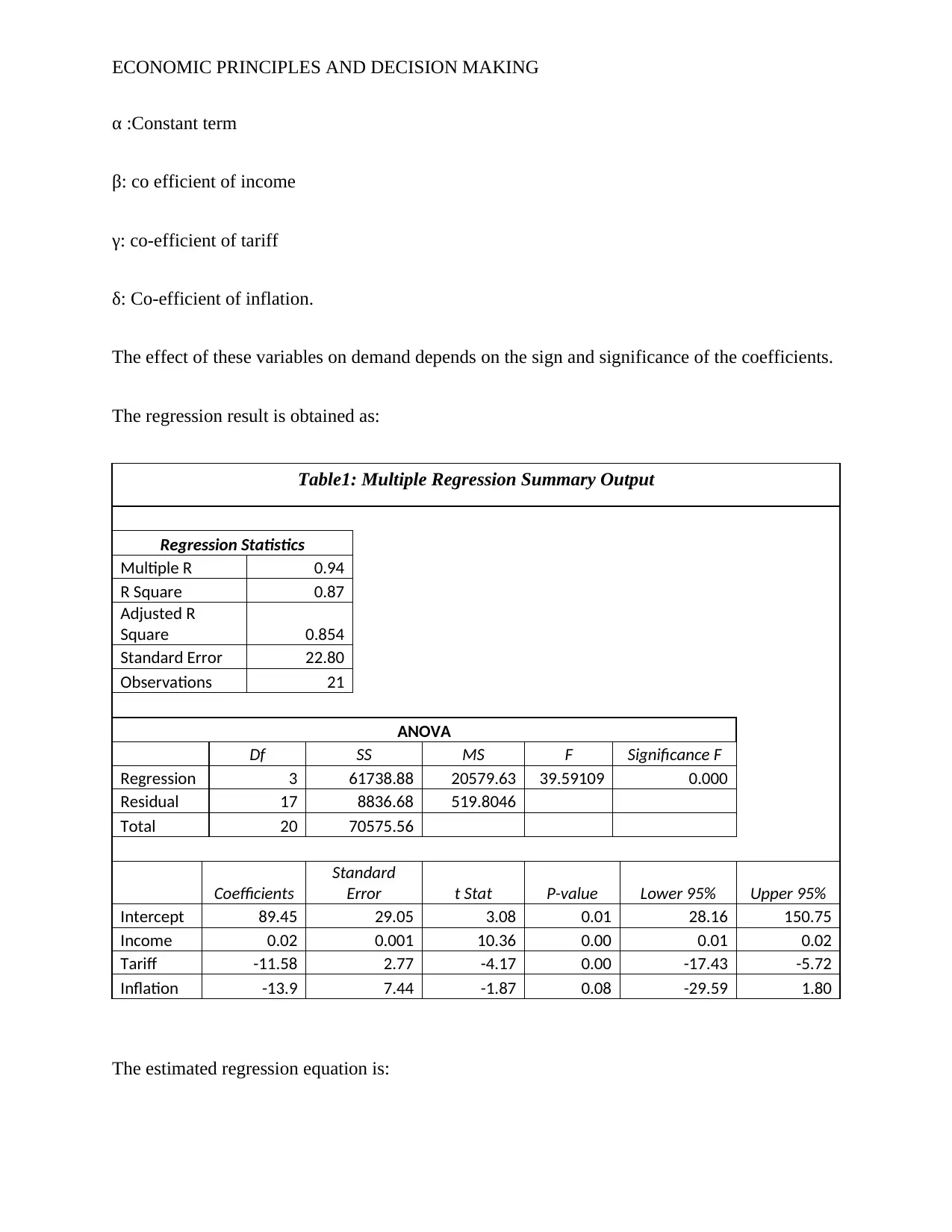
ECONOMIC PRINCIPLES AND DECISION MAKING
α :Constant term
β: co efficient of income
γ: co-efficient of tariff
δ: Co-efficient of inflation.
The effect of these variables on demand depends on the sign and significance of the coefficients.
The regression result is obtained as:
Table1: Multiple Regression Summary Output
Regression Statistics
Multiple R 0.94
R Square 0.87
Adjusted R
Square 0.854
Standard Error 22.80
Observations 21
ANOVA
Df SS MS F Significance F
Regression 3 61738.88 20579.63 39.59109 0.000
Residual 17 8836.68 519.8046
Total 20 70575.56
Coefficients
Standard
Error t Stat P-value Lower 95% Upper 95%
Intercept 89.45 29.05 3.08 0.01 28.16 150.75
Income 0.02 0.001 10.36 0.00 0.01 0.02
Tariff -11.58 2.77 -4.17 0.00 -17.43 -5.72
Inflation -13.9 7.44 -1.87 0.08 -29.59 1.80
The estimated regression equation is:
α :Constant term
β: co efficient of income
γ: co-efficient of tariff
δ: Co-efficient of inflation.
The effect of these variables on demand depends on the sign and significance of the coefficients.
The regression result is obtained as:
Table1: Multiple Regression Summary Output
Regression Statistics
Multiple R 0.94
R Square 0.87
Adjusted R
Square 0.854
Standard Error 22.80
Observations 21
ANOVA
Df SS MS F Significance F
Regression 3 61738.88 20579.63 39.59109 0.000
Residual 17 8836.68 519.8046
Total 20 70575.56
Coefficients
Standard
Error t Stat P-value Lower 95% Upper 95%
Intercept 89.45 29.05 3.08 0.01 28.16 150.75
Income 0.02 0.001 10.36 0.00 0.01 0.02
Tariff -11.58 2.77 -4.17 0.00 -17.43 -5.72
Inflation -13.9 7.44 -1.87 0.08 -29.59 1.80
The estimated regression equation is:
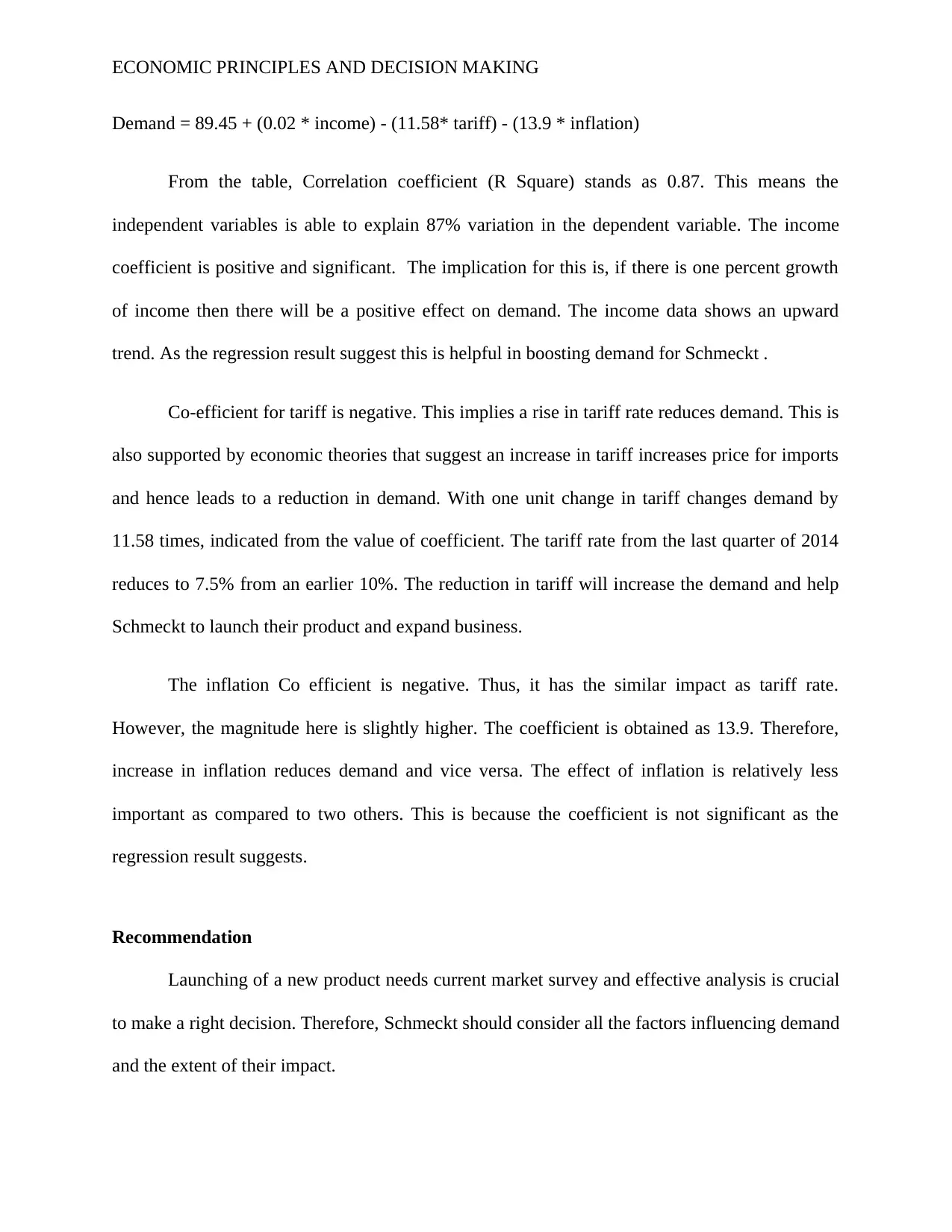
ECONOMIC PRINCIPLES AND DECISION MAKING
Demand = 89.45 + (0.02 * income) - (11.58* tariff) - (13.9 * inflation)
From the table, Correlation coefficient (R Square) stands as 0.87. This means the
independent variables is able to explain 87% variation in the dependent variable. The income
coefficient is positive and significant. The implication for this is, if there is one percent growth
of income then there will be a positive effect on demand. The income data shows an upward
trend. As the regression result suggest this is helpful in boosting demand for Schmeckt .
Co-efficient for tariff is negative. This implies a rise in tariff rate reduces demand. This is
also supported by economic theories that suggest an increase in tariff increases price for imports
and hence leads to a reduction in demand. With one unit change in tariff changes demand by
11.58 times, indicated from the value of coefficient. The tariff rate from the last quarter of 2014
reduces to 7.5% from an earlier 10%. The reduction in tariff will increase the demand and help
Schmeckt to launch their product and expand business.
The inflation Co efficient is negative. Thus, it has the similar impact as tariff rate.
However, the magnitude here is slightly higher. The coefficient is obtained as 13.9. Therefore,
increase in inflation reduces demand and vice versa. The effect of inflation is relatively less
important as compared to two others. This is because the coefficient is not significant as the
regression result suggests.
Recommendation
Launching of a new product needs current market survey and effective analysis is crucial
to make a right decision. Therefore, Schmeckt should consider all the factors influencing demand
and the extent of their impact.
Demand = 89.45 + (0.02 * income) - (11.58* tariff) - (13.9 * inflation)
From the table, Correlation coefficient (R Square) stands as 0.87. This means the
independent variables is able to explain 87% variation in the dependent variable. The income
coefficient is positive and significant. The implication for this is, if there is one percent growth
of income then there will be a positive effect on demand. The income data shows an upward
trend. As the regression result suggest this is helpful in boosting demand for Schmeckt .
Co-efficient for tariff is negative. This implies a rise in tariff rate reduces demand. This is
also supported by economic theories that suggest an increase in tariff increases price for imports
and hence leads to a reduction in demand. With one unit change in tariff changes demand by
11.58 times, indicated from the value of coefficient. The tariff rate from the last quarter of 2014
reduces to 7.5% from an earlier 10%. The reduction in tariff will increase the demand and help
Schmeckt to launch their product and expand business.
The inflation Co efficient is negative. Thus, it has the similar impact as tariff rate.
However, the magnitude here is slightly higher. The coefficient is obtained as 13.9. Therefore,
increase in inflation reduces demand and vice versa. The effect of inflation is relatively less
important as compared to two others. This is because the coefficient is not significant as the
regression result suggests.
Recommendation
Launching of a new product needs current market survey and effective analysis is crucial
to make a right decision. Therefore, Schmeckt should consider all the factors influencing demand
and the extent of their impact.
⊘ This is a preview!⊘
Do you want full access?
Subscribe today to unlock all pages.

Trusted by 1+ million students worldwide
1 out of 16
Related Documents
Your All-in-One AI-Powered Toolkit for Academic Success.
+13062052269
info@desklib.com
Available 24*7 on WhatsApp / Email
![[object Object]](/_next/static/media/star-bottom.7253800d.svg)
Unlock your academic potential
Copyright © 2020–2025 A2Z Services. All Rights Reserved. Developed and managed by ZUCOL.





